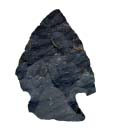



There are many types of rocks, all with slightly unique properties. Some rocks are hard and difficult to break while others are soft and easily crushed. Those rocks that do not break too easily are the best type to make tools out of. This should make sense because, you wouldn't want your hammer to break in half every time you use it. However, if you need your stone tool to be a different shape, you want to chose a rock that isn't too hard to break. Therefore, certain rocks make better kinds of stone tools than others based on its properties.
An expedient stone tool is one that is made quickly and easily to preform a specific immediate task. This category includes:
A refined tool is one that is made to a specific shape for a task. These tools take longer to make and require more skill. This category includes:
These are just a few examples of the many lithic artifacts that can be found. Stay tuned for a more complete listing in an upcoming Lithic Artifacts page.
To make a chipped stone tool, whether it is a scraper or a projectile point, the rock the tool will be made from must be struck with another object, usually a harder rock, to cause the desired break. This simple action leaves a set of tell tale marks on the struck rock (now called a core) and on the piece of rock that has been broken off (now called a flake) which tell archaeologists that the break was intentionally made.
Understanding how archaeologists know when a piece of rock is really a lithic artifact requires just a little bit of physics. Physics tells us that the force of the blow as the core is struck with a hammerstone is greatest at the point of contact. This force then dissipates (lessens) as it travels through the rock. This dissipation is caused by the use of the force to break the rock.
What all this physics tells archaeologists is that a lithic flake will have a shape which resembles a feather, wider at one end and thinner at the opposite end. The wider end of the flake will also be thicker than the opposite end. This wider and thicker part of a flake is called the striking platform because it tells us exactly where the core was hit to create that flake.
Just below the striking platform of the flake there should be a thick rounded bump. This bump is called the bulb of percussion (a fancy way to say bump caused by the force of hitting the rock).
The bulb of percussion is important because it leaves a rounded depression in the core rock when it is made. A core rock is therefore identifiable as a lithic artifact because of the flake scars that remain on its surface. If you look closely at the picture of the projectile point at the top of this page you can seem many little depressions on it. These depressions are the result of little flakes being knocked off of the point in the process of shaping it.
1993 Making Silent Stones Speak by K.D. Schick and N. Toth, Touchstone/Simon & Schuster, NY.
Not sure of a word? Try the glossary.
Return to home page.
April M. Beisaw